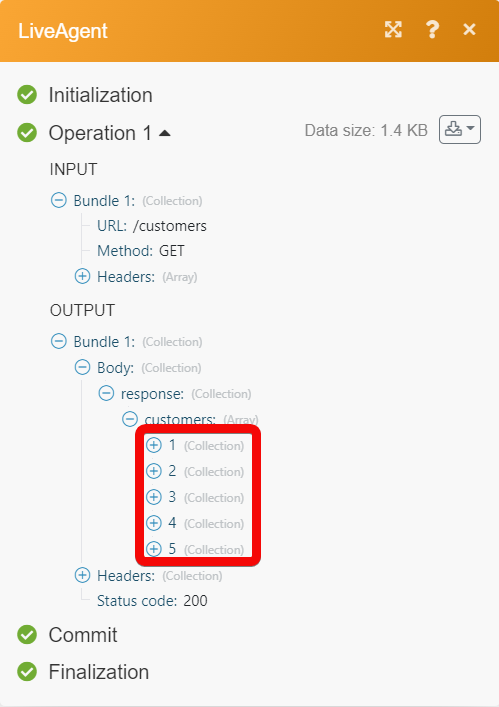| Active with remarks |
|---|
| This application needs additional settings. Please follow the documentation below to create your own connectionUnique, active service acces point to a network. There are different types of connections (API key, Oauth…). More. |
The LiveAgent modulesThe module is an application or tool within the Boost.space system. The entire system is built on this concept of modularity. (module - Contacts) More allow you to list, retrieve, create, add, remove, and delete the customers, conversations, and groups from your LiveAgent account.
Prerequisites
-
A LiveAgent account – create an account at liveagent.com.
![[Note]](https://docs.boost.space/wp-content/themes/bsdocs/docs-parser/HTML/css/image/note.png) |
Note |
|---|---|
|
The moduleThe module is an application or tool within the Boost.space system. The entire system is built on this concept of modularity. (module - Contacts) More dialog fields that are displayed in bold (in the Boost.spaceCentralization and synchronization platform, where you can organize and manage your data. More IntegratorPart of the Boost.space system, where you can create your connections and automate your processes. More scenarioA specific connection between applications in which data can be transferred. Two types of scenarios: active/inactive. More, not in this documentation article) are mandatory! |
To connect your LiveAgent account to Boost.space Integrator you need to obtain the API Key and Domain URL from your LiveAgent account and insert it in the Create a connection dialog in the Boost.space Integrator module.
1. Log in to your LiveAgent account.
2. Click Settings.
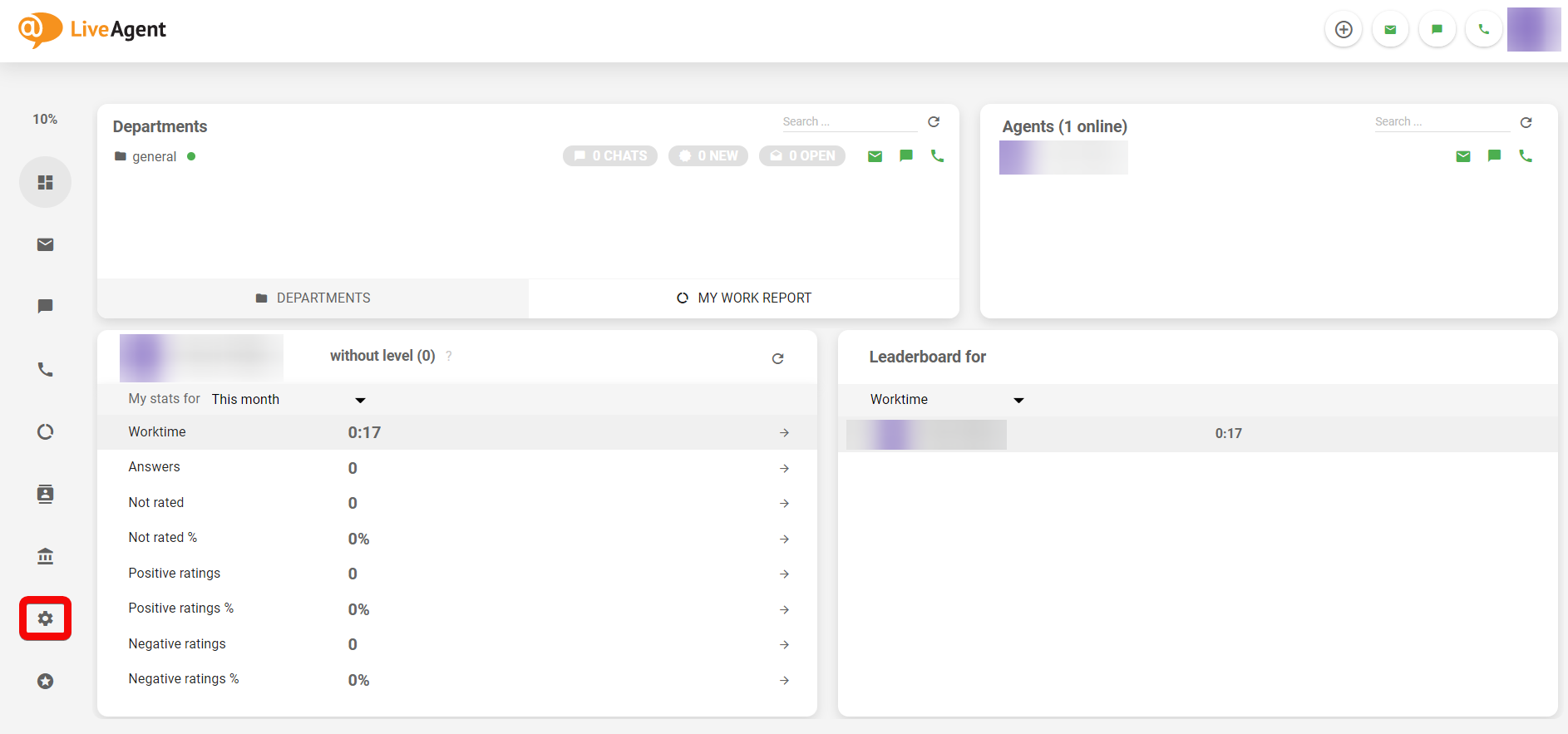
2. Click System>API>Settings for API V1.
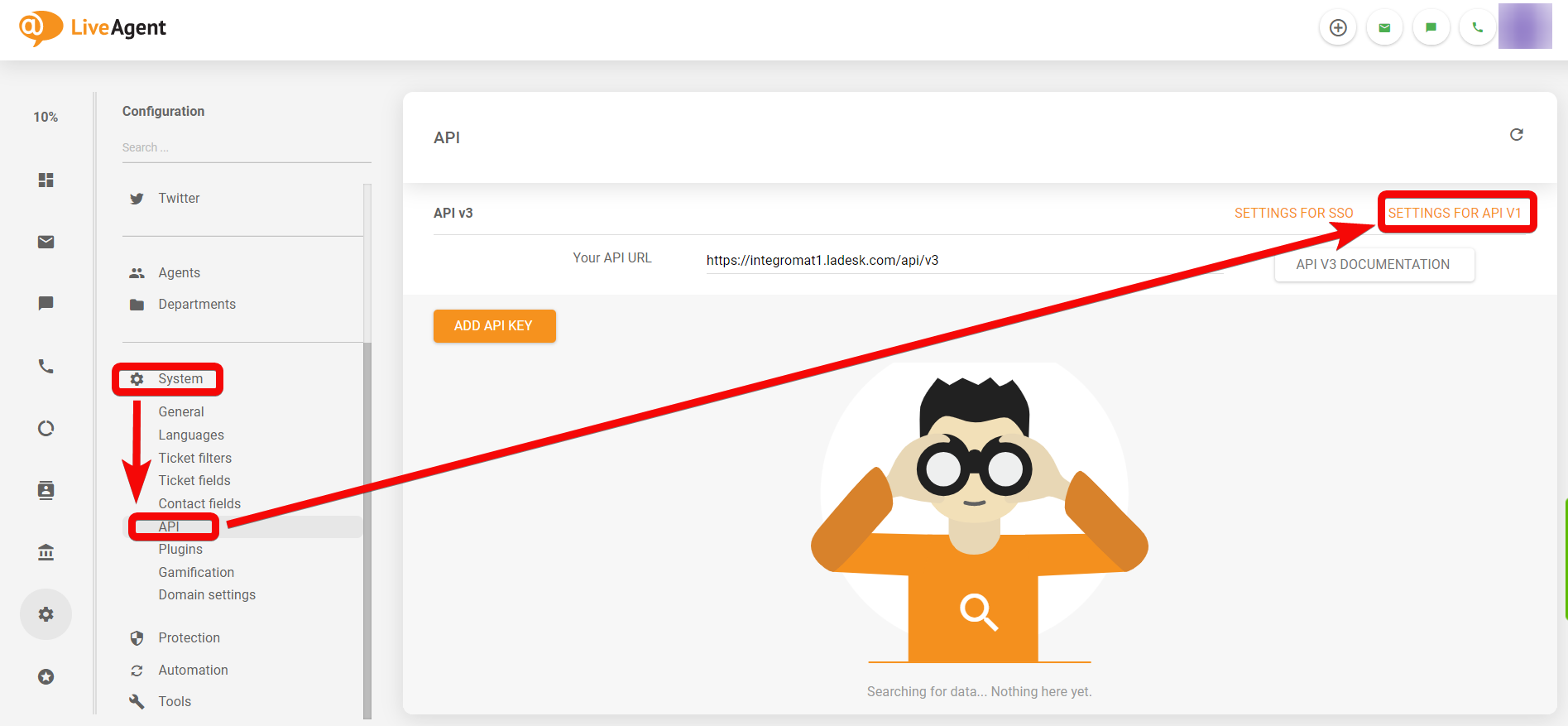
3. Copy the API Key and Your APIURL to your clipboard.
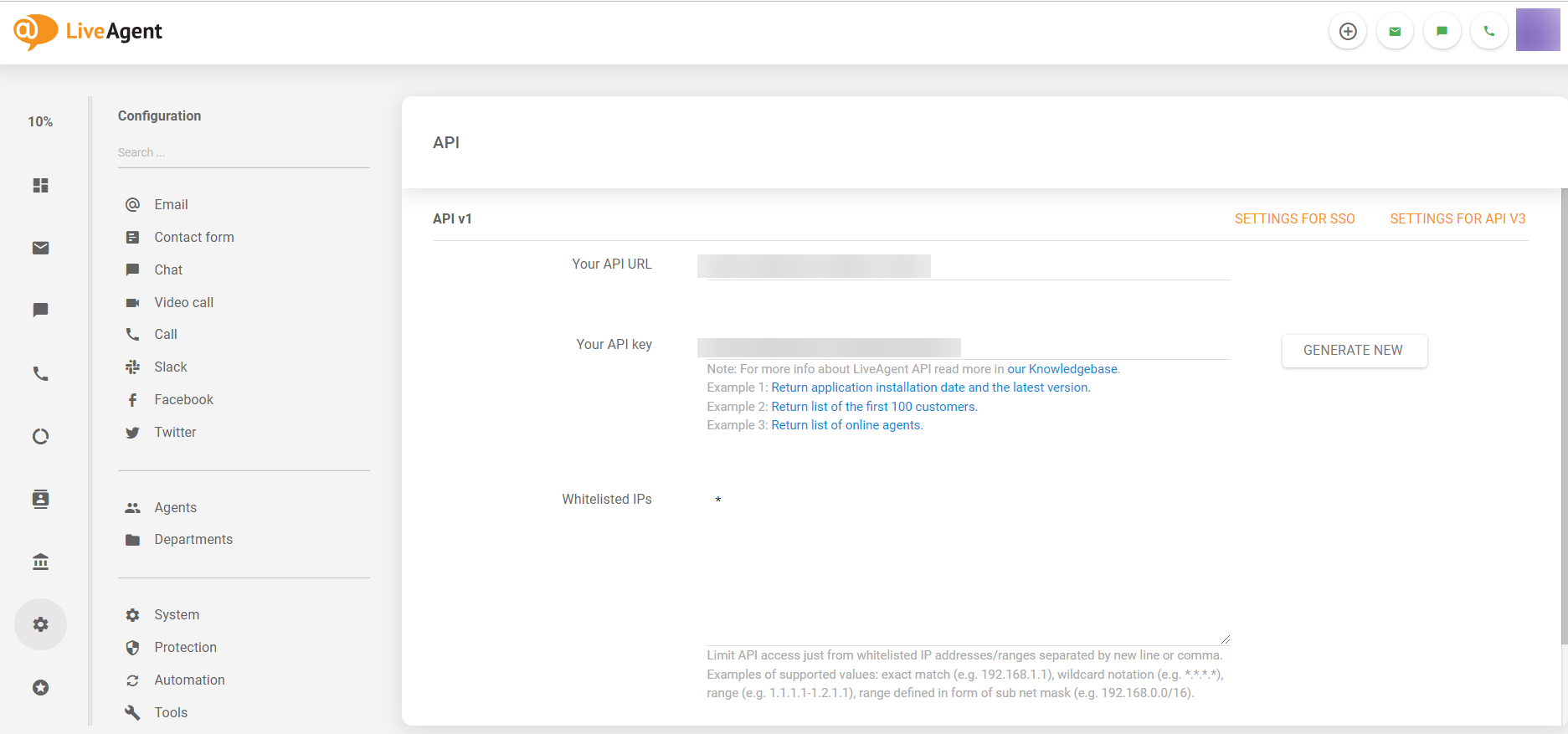
4. Log in to your Boost.space Integrator account, add a module from the LiveAgent app into an Boost.space Integrator scenario.
5. Click Add next to the Connection field.
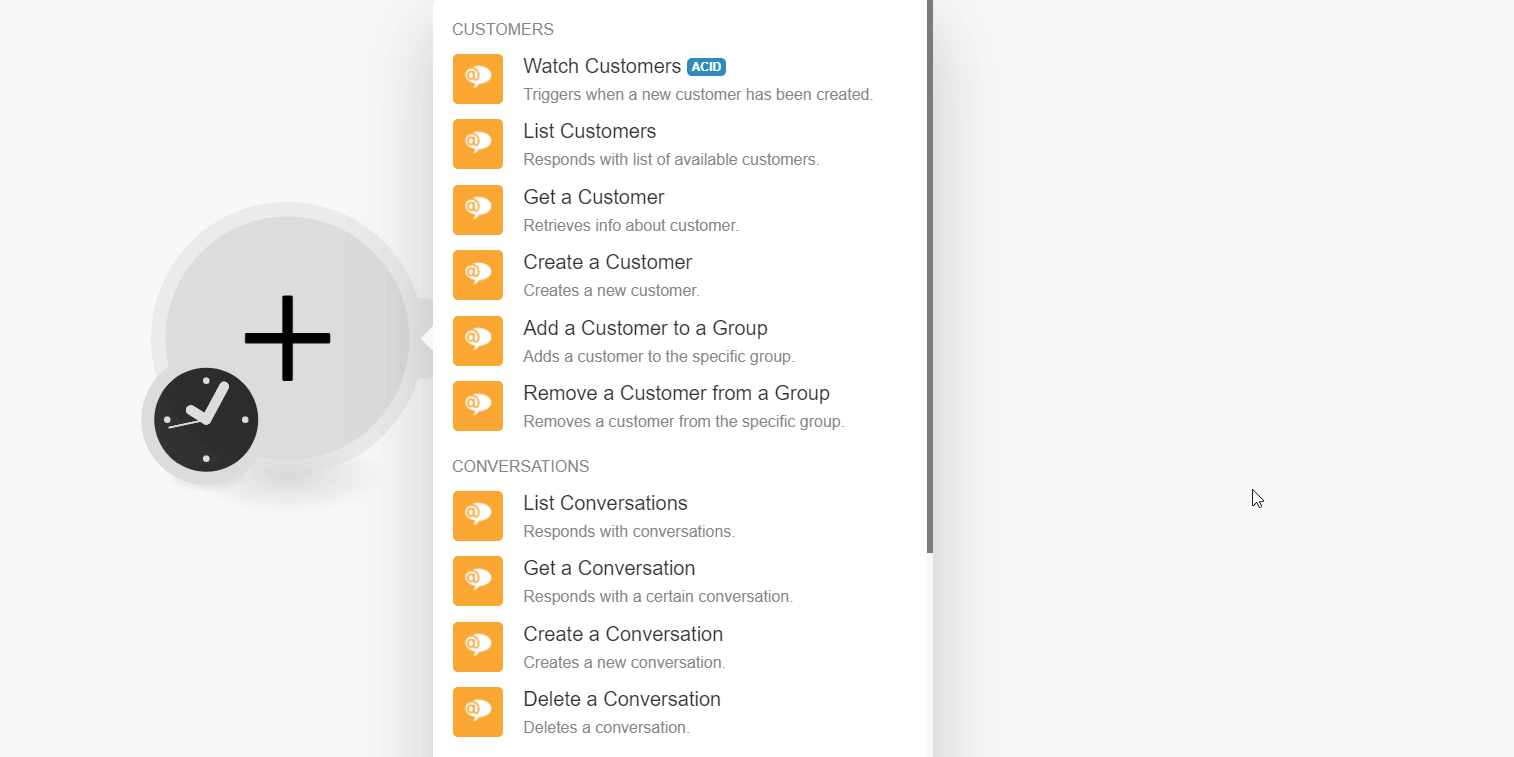
6. In the Connection name field, enter a name for the connection.
7. In the API Key and Domain URLfield, enter the details copied in step 3 and click Continue.
The connection has been established.
TriggersEvery scenario has a trigger, an event that starts your scenario. A scenario must have a trigger. There can only be one trigger for each scenario. When you create a new scenario, the first module you choose is your trigger for that scenario. Create a trigger by clicking on the empty module of a newly created scenario or moving the... when a new customer has been created.
|
Connection |
|
|
Limit |
Set the maximum number of results Boost.space Integrator should return during one execution cycleA cycle is the operation and commit/rollback phases of scenario execution. A scenario may have one or more cycles (one is the default).. The default value is 10. |
Responds with a list of available customers.
|
Connection |
|
|
|
Select or map the email address to list the customer that matches the specified email address. |
|
Phone |
Enter (map) the phone number to list the customers that match the specified number. |
|
|
Enter (map) the Facebook UserCan use the system on a limited basis based on the rights assigned by the admin. More ID to list the customers that match the specified ID. |
|
|
Enter (map) the Twitter ID to list the customers that match the specified ID. |
|
First Name |
Enter (map) the first name of the customers to list the customers that match the specified name. |
|
Last Name |
Enter (map) the last name of the customers to list the customers that match the specified name. |
|
Company ID |
Enter (map) the Company ID to list the customers that match the specified ID. |
|
Date Created From |
Enter (map) a date to list the customers that are created on or after the specified time. See the list of supported date and time formats. |
|
Date Created To |
Enter (map) a date to list the customers that are created on or before the specified time. See the list of supported date and time formats. |
|
Limit |
Set the maximum number of results Boost.space Integrator should return during one execution cycle. The default value is 10. |
Retrieves info about customers.
|
Connection |
|
|
Contact ID |
Select or map the Contact ID whose details you want to retrieve. |
Creates a new customer.
|
Connection |
|||||
|
|
Enter (map) the email address of the customer. |
||||
|
Phone |
Enter (map) the phone number of the customer. |
||||
|
Name |
Enter (map) the customer’s name in the first name last name format. |
||||
|
Gender |
Select or map the gender of the customer:
|
||||
|
Role |
Select the role of the customer:
|
||||
|
Password |
Enter (map) the password for the customer.
|
||||
|
Unique Fields |
Enter (map) the additional unique field values:
|
||||
|
Custom FieldsA feature in Boost.space that allows you to define and manage data within each module according to your specific needs. More |
Enter (map) the custom fieldA feature in Boost.space that allows you to define and manage data within each module according to your specific needs. More values:
|
||||
|
Customer Note |
Enter (map) additional information about the customer. |
||||
|
Send Registration Email |
Select whether you want to send the registration email to the customer. |
Adds a customer to the specific group.
|
Connection |
|
|
Customer ID |
Select or map the Customer ID you want to add to the group. |
|
Group Name |
Select or map the group name to which you want to add the customer. |
Removes a customer from a specific group.
|
Connection |
|
|
Customer ID |
Select or map the Customer ID you want to remove from the group. |
|
Group Name |
Select or map the group name from which you want to remove the customer. |
Responds with conversations.
|
Connection |
|
|
Department ID |
Select or map the Department ID whose conversations you want to list. |
|
OwnerCan manage members, managers and owners of a specific space. Can view and manage items. Can edit settings of a given space. More ID |
Enter (map) the Owner ID to list the conversations that match the specified ID. This could be the Email ID of the customer. |
|
Agent |
Enter (map) the agent identifier to list the conversations that match the specified identifier. This could be the USer ID or Email ID. |
|
StatusCreate statuses for each module separately to create an ideal environment for efficient and consistent work. More |
Enter (map) the status to list the conversations that match the specified status. It can contain one specific status or multiple statusesCreate statuses for each module separately to create an ideal environment for efficient and consistent work. More separated by a comma. |
|
Date From |
Enter (map) a date to list the conversations that were created on or after the specified date. See the list of supported date and time formats. |
|
Date To |
Enter (map) a date to list the conversations that were created on or before the specified date. See the list of supported date and time formats. |
|
Date Changed |
Enter (map) a date to list the conversation that was changed on the specified date. See the list of supported date and time formats. |
|
Subject |
Enter (map) the subject of the conversation you want to list. |
|
Channel Type |
Enter (map) the channel type to list the conversations. It can contain one specific channel type or multiple channel types separated by a comma. |
|
Limit |
Set the maximum number of results Boost.space Integrator should return during one execution cycle. The default value is 10. |
Responds with a certain conversation.
|
Connection |
|
|
Conversation ID |
Select or map the Conversation ID whose details you want to retrieve. |
Creates a new conversation.
|
Connection |
|||||
|
Message |
Enter (map) the message text of the conversation. |
||||
|
Department ID |
Select or map the Department ID to which the conversation is associated. |
||||
|
User Identifier |
Enter (map) the user identifier to create a new conversation. This can be the User ID or Email of an existing agent or the Email of an existing visitor. |
||||
|
Message Subject |
Enter (map) the subject of the message. |
||||
|
Recipient |
Select or map the recipient’s email address. If the User Identifier is a visitor, the recipient must be a LiveAgent mail account. If the User Identifier is an agent, the recipient must be a visitor. |
||||
|
Recipient Name |
Enter (map) the recipient name in Firstname Lastname format. |
||||
|
CC |
Enter (map) the recipient’s email addresses you want to add in the CC field of the email. |
||||
|
Status |
Select the status of the conversation:
|
||||
|
Mail Message ID |
Enter (map) the Mail Message ID of the conversation. If specified, all reply emails which will have given mail message-id in the in-reply-to header will be assigned to this conversation. |
||||
|
Do Not Send Mail |
Select whether to send an email to the customer. |
||||
|
Use TemplateTemplates are predefined scenarios that you can expand and customize to create new scenarios. You can then share these with friends and colleagues. More |
Select whether to use the department mail template and add a message into the mail template text. |
||||
|
Is HTML Message |
Select whether to format this message in HTML format. |
||||
|
Custom Fields |
Enter (map) the custom field values:
|
||||
|
Attachments |
|
Deletes a conversation.
|
Connection |
|
|
Conversation ID |
Select or map the Conversation ID you want to delete. |
|
Note |
Enter (map) the additional information for deleting the conversation. |
|
User ID |
Select or map the User ID whose conversations you want to delete. |
Gets all groups.
|
Connection |
|
|
Limit |
Set the maximum number of results Boost.space Integrator should return during one execution cycle. The default value is 10. |
Responds with a group.
|
Connection |
|
|
Group ID |
Select or map the Group ID whose details you want to retrieve. |
Creates a new customer group.
|
Connection |
|
|
Name |
Enter (map) a name for the customer’s group. |
|
Color |
Enter (map) the color for the group name. |
|
Background Color |
Enter (map) the background color for the group. |
Updates a certain group.
|
Connection |
|
|
Group ID |
Select or map the Group ID whose details you want to update. |
|
Name |
Enter (map) a new name for the customer’s group. |
|
Color |
Enter (map) the color for the group name. |
|
Background Color |
Enter (map) the background color for the group. |
Deletes a customer group.
|
Connection |
|
|
Group ID |
Select or map the Group ID you want to delete. |
Performs an arbitrary authorized API Call.
|
Connection |
||||
|
URL |
Enter a path relative to
|
|||
|
Method |
Select the HTTP method you want to use: GET to retrieve information for an entry. POST to create a new entry. PUT to update/replace an existing entry. PATCH to make a partial entry update. DELETE to delete an entry. |
|||
|
Headers |
Enter the desired request headers. You don’t have to add authorization headers; we already did that for you. |
|||
|
Query String |
Enter the request query string. |
|||
|
Body |
Enter the body content for your API call. |
The following API call returns all the customers from your LiveAgent account:
URL: /customers
Method: GET
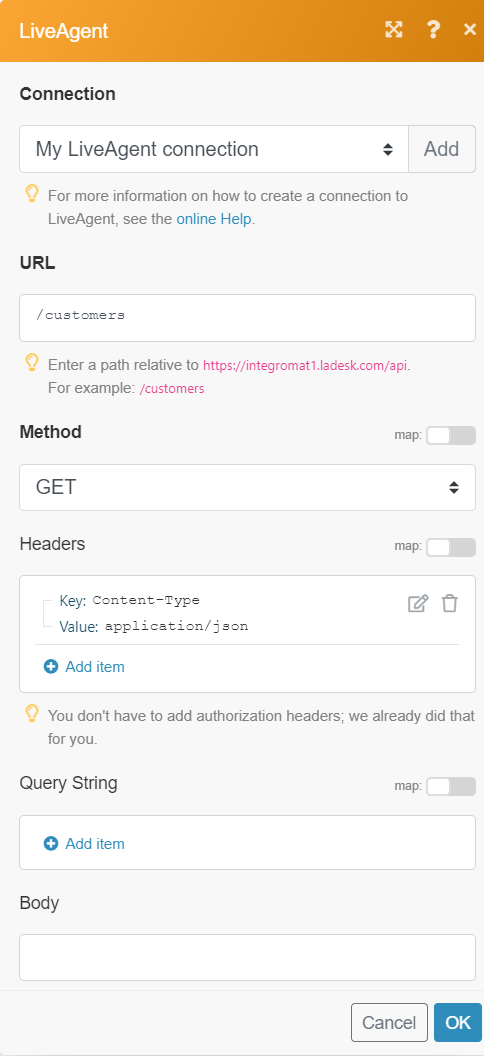
Matches of the search can be found in the module’s Output under BundleA bundle is a chunk of data and the basic unit for use with modules. A bundle consists of items, similar to how a bag may contain separate, individual items. More > Body > response > customers. In our example, 5 customers were returned:
